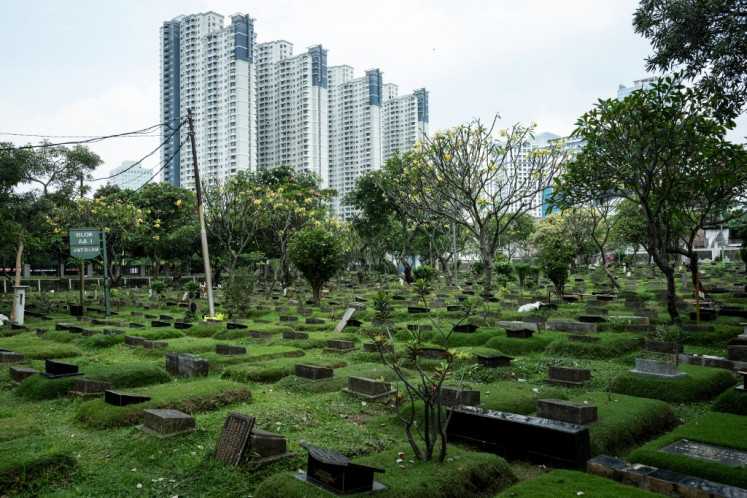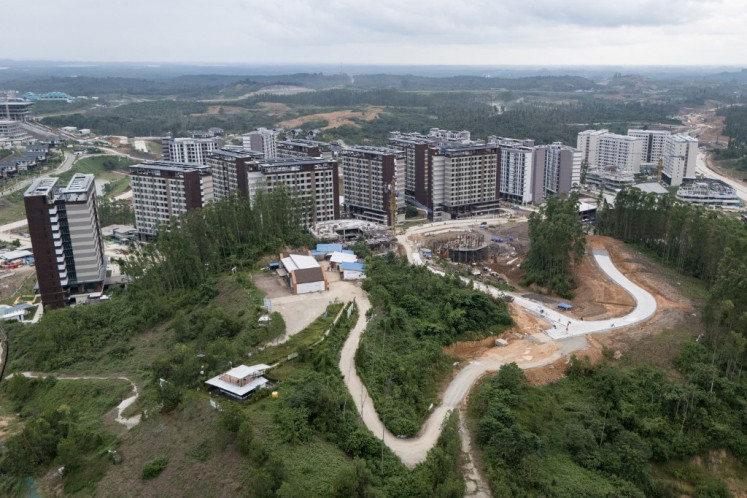Popular Reads
Top Results
Can't find what you're looking for?
View all search resultsPopular Reads
Top Results
Can't find what you're looking for?
View all search resultsThe plight and plea of Menteng
Menteng is no longer a conservation area
Change text size
Gift Premium Articles
to Anyone
Menteng is no longer a conservation area. This is not a statement from a legal point of view, of course, but from the reality in the field. The irony is that legally it is. The conservationist perspective has long prevented it from being looked at as to its real, basic problem: How to maintain a comfortable living in the city’s center.
What is happening there is, first of all, not a destruction of a shared colonial heritage, but simply a destruction of a good-quality residential neighbourhood.
It is an epitome of what is happening to the whole of Jakarta, as it is being turned into a gigantic machine to earn a living, with little left for living itself.
The Jakarta Post recently reported the increasing conversion of residences into business establishments, and all the vices and complaints it has generated, in two of the most interesting residential neighbourhoods in Jakarta – Kebayoran Baru and Menteng – despite the fact that they are legally protected as residential areas and conservation sites of significant heritage value.
Some houses in Menteng are quietly converted, without any sign of even the name of the establishment, for example a spa and salon on Jl. Situbondo, and the boutique of an important brand on Jl. Purworejo, as they know that it is against the regulations that are ironically proclaimed on boards on sidewalks nearby.
The thing is that they cater to the real needs of the rich and famous in the neighbourhood. So, what to do? Should we live with the hypocrisy of ignoring the breachs of regulations? Or should we find a reasonable compromise?
The question is how to prevent a compromise being the first push in a domino effect that will eventually bring the whole of Menteng down.
It is no longer about conservation, but simply about a tasteful residential area.
It is no longer about arguing for conservation – it is too late – but simply for a quality environment with tasteful residences, which are increasingly being replaced by cheap and disgraceful-looking buildings like those in Pluit, such as the repulsively overwhelming Jl. Sawo, for example. Here, the whole idea of a Menteng streetscape is gone, with even its sidewalks privatised.
All possible planning exercises have been made with its physical conservation as their main focus. This good intention seems to have paved the way toward the very destruction of a more basic importance: a quality residential area. The conservationists have missed its urban planning dimensions.
The widening of the Kuningan bridge that will bring more traffic into the area and increase the use of its residential streets for U-turns; a pretentious park with a multilevel parking garage serving cheap hotels; and other buildings with higher Floor Area Ratio (FAR) on Jl. Cokroaminoto that will change the street from being a local service area to a city-wide service area, will soon initiate the domino effect to the whole of Menteng.
And, how can we expect retired pensioners to maintain their houses, literally condemned as heritage sites, without any subsidies or tax incentives?
The paradox is that the better the upkeep of his/her house in Menteng, the bigger chance there is for the house to be condemned into a higher conservation category.
Some houses are therefore left to rot. And when it has rotted enough, permission is “requested” to build a new building on it, most of the time much bigger and uglier than the original.
One arguably successfully restored heritage building is the Kunstkring or Gedung Imigrasi. It has been repurchased and restored with public money, but now has lost its publicness completely.
It is now a stylish (?) restaurant run by a company; how the company was chosen, we will never know. I am particularly upset by the fact that the plant vendors under the overhead railway tracks at the eastern border of the restaurant have been partly evicted to make space for the parking lot.
On the positive side, strangely, there have been emerging new restaurants along Jl. Cikini over the past few years, adapting the old shop-houses elegantly.
There is a sense of reviving the old street as a high street, as it had meant to be in colonial times. These new establishments find the art deco architecture of the shop-houses serve their clients quite well. Perhaps, because it conforms to the taste of the upcoming yuppies. In any case, it just happened, luckily for the better. No policy required, it is the invisible hand of the market working.
We are also witnessing more high-rise towers popping up in Menteng, for example at Jl. Cikditiro. Again, it raises the question: how could they have been allowed?
The fact is that the population of the Kecamatan district, Menteng from 2001 to 2006 showed a decreasing trend, after a brief surge in 2002, when the population was at the highest, at 98,123 up from 73,546 in 2001.
From 2004 (80,404) the population decreased consistently to 79,430 in 2005, and 77,835 in 2006. Graphically, the trend is parallel with the overall nighttime population of Jakarta, which was also consistently decreasing, from 8,374,005 in 2001 to 7,554,761 in 2006, after a brief surge in 2004 (election year!) to 9,341,866.
Altogether, the population of South and Central Jakarta is also decreasing in absolute terms, while that in Jakarta’s surrounding peripheral suburbs and districts is increasing dramatically.
The traffic jams in South and Central Jakarta are caused, therefore, not by the increasing population inside Jakarta, but rather by the increasing population in its surrounding suburbs and districts, that swarm into Jakarta in the morning and leave it in the early evening as commuters.
Will the whole of Jakarta’s population decrease, making the “black hole” expanding from South and Central Jakarta eventually engulf the whole of Jakarta?
The emerging high-rise appartment buildings may help a bit, but only really for the upper class, who is never known for its contribution to real urban life on the ground floor of any city.
The writer is an urbanist.










